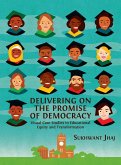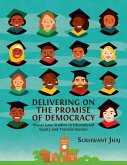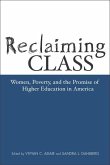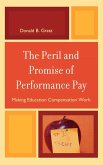Making Good on the Promise
Student Affairs Professionals With Disabilities
Herausgeber: Higbee, Jeanne L.; Mitchell, Alice A.
Making Good on the Promise
Student Affairs Professionals With Disabilities
Herausgeber: Higbee, Jeanne L.; Mitchell, Alice A.
- Broschiertes Buch
- Merkliste
- Auf die Merkliste
- Bewerten Bewerten
- Teilen
- Produkt teilen
- Produkterinnerung
- Produkterinnerung
This book gets to the heart of the experience of student affairs professionals with disabilities, to the curricular changes needed in preparation programs for that profession, to the role and appropriate action needed by allies, and to resources that all can use in the education of self and others.
Andere Kunden interessierten sich auch für
![The Unfulfilled Promise The Unfulfilled Promise]() Khritish SwargiaryThe Unfulfilled Promise53,99 €
Khritish SwargiaryThe Unfulfilled Promise53,99 €![Delivering on the Promise of Democracy Delivering on the Promise of Democracy]() Sukhwant JhajDelivering on the Promise of Democracy45,99 €
Sukhwant JhajDelivering on the Promise of Democracy45,99 €![Delivering on the Promise of Democracy Delivering on the Promise of Democracy]() Sukhwant JhajDelivering on the Promise of Democracy32,99 €
Sukhwant JhajDelivering on the Promise of Democracy32,99 €![Trains of Promise Trains of Promise]() Charlotte EndorfTrains of Promise18,99 €
Charlotte EndorfTrains of Promise18,99 €![Peril and Promise of Performance Pay Peril and Promise of Performance Pay]() Donald B. GratzPeril and Promise of Performance Pay60,99 €
Donald B. GratzPeril and Promise of Performance Pay60,99 €![Reclaiming Class: Women, Poverty, and the Promise of Higher Education in America Reclaiming Class: Women, Poverty, and the Promise of Higher Education in America]() Sandra L. DahlbergReclaiming Class: Women, Poverty, and the Promise of Higher Education in America71,99 €
Sandra L. DahlbergReclaiming Class: Women, Poverty, and the Promise of Higher Education in America71,99 €![Peril and Promise of Performance Pay Peril and Promise of Performance Pay]() Donald B. GratzPeril and Promise of Performance Pay144,99 €
Donald B. GratzPeril and Promise of Performance Pay144,99 €-
-
-
This book gets to the heart of the experience of student affairs professionals with disabilities, to the curricular changes needed in preparation programs for that profession, to the role and appropriate action needed by allies, and to resources that all can use in the education of self and others.
Produktdetails
- Produktdetails
- Verlag: University Press of America
- Seitenzahl: 254
- Erscheinungstermin: 29. Januar 2009
- Englisch
- Abmessung: 229mm x 152mm x 15mm
- Gewicht: 418g
- ISBN-13: 9780761845645
- ISBN-10: 076184564X
- Artikelnr.: 26057183
- Herstellerkennzeichnung
- Libri GmbH
- Europaallee 1
- 36244 Bad Hersfeld
- gpsr@libri.de
- Verlag: University Press of America
- Seitenzahl: 254
- Erscheinungstermin: 29. Januar 2009
- Englisch
- Abmessung: 229mm x 152mm x 15mm
- Gewicht: 418g
- ISBN-13: 9780761845645
- ISBN-10: 076184564X
- Artikelnr.: 26057183
- Herstellerkennzeichnung
- Libri GmbH
- Europaallee 1
- 36244 Bad Hersfeld
- gpsr@libri.de
Jeanne L. Higbee has worked in higher education settings since 1974 in a career that has bridged student affairs and teaching. Currently, she is a professor in the Department of Postsecondary Teaching and Learning at the University of Minnesota, Twin Cities. She is a recipient of the ACPA-College Student Educators International Voice of Inclusion Medallion and Disability Ally Award , an ACPA Educational Leadership Foundation Diamond Honoree, the Robert Griffin Long and Outstanding Service Award from the College Reading and Learning Association, and the Henry Young Award for Outstanding Individual Contribution to the National Association for Developmental Education. Alice A. Mitchell has been in student affairs since 1978 in admissions, residence life, career services, commuter student services, and other areas. Currently she is psychometrist (director of the testing office within the Counseling Center) at the University of Maryland, College Park. In ACPA-College Student Educators International, she is the immediate past chair of the Commission on Assessment and Evaluation and is currently coordinator for commissions. She is a recipient of the ACPA-College Student Educators International Voice of Inclusion Medallion and has been a Diamond Honoree of the ACPA Educational Leadership Foundation. She is the founding chair of the ACPA Standing Committee on Disability.
Part 1 Foreword
Part 2 Preface
Part 3 Section I-Introduction
Part 4 Chapter 1-Disability Realities: Community, Culture, and Connection
on College Campuses
Part 5 Chapter 2-Philosophical and Theoretical Approaches to Disability
Part 6 Section II-Voices of Inclusion
Part 7 Chapter 3-A Fabric of Similarity and Difference: First-Person
Accounts
Part 8 Introduction
Part 9 The Invasive Nature of Depression: Psychiatric Disability
Part 10 A Push in a Significant Direction: Mobility Impairment
Part 11 An Intersection of Multiple Identities: Congenital Limb Amputation
Part 12 An Unexpected Additional Identity: Human Immune Deficiency (HIV)
Part 13 An Invisible Identity: Learning Disability
Part 14 Creating a Path for Career Advancement: Cerebral Palsy
Part 15 A New Way of Seeing the World: Acquired Vision Impairment
Part 16 Determination Points the Way for Others: Congenital Vision
Impairment
Part 17 Finding a Welcoming Environment: Deafness and Hearing Impairment
Part 18 Conclusion
Part 19 Section III-Theory and Practice
Part 20 Chapter 4-Integrating Disability Into the Diversity Framework in
the Training of Student Affairs Professionals
Part 21 Chapter 5-Making Graduate Preparation Programs and Assistantships
in the Field of Student Affairs More Accessible
Part 22 Section IV-The Role of Allies
Part 23 Chapter 6-Allies in our Midst
Part 24 Chapter 7-Turning Missteps into Forward Steps: A Guide for Allies
Part 25 Introduction
Part 26 Being an Ally in Language Use
Part 27 The Informed Use of Simulation Activities: A Personal Perspective
Part 28 Disclosure
Part 29 "Getting It" as an Ally: Interpersonal Relationships Between
Colleagues With and Without Disabilities
Part 30 Section V-Resources and Conclusion
Part 31 Chapter 8-Educating Yourself and Others: Utilizing Resources and
Disability Networks
Part 2 Preface
Part 3 Section I-Introduction
Part 4 Chapter 1-Disability Realities: Community, Culture, and Connection
on College Campuses
Part 5 Chapter 2-Philosophical and Theoretical Approaches to Disability
Part 6 Section II-Voices of Inclusion
Part 7 Chapter 3-A Fabric of Similarity and Difference: First-Person
Accounts
Part 8 Introduction
Part 9 The Invasive Nature of Depression: Psychiatric Disability
Part 10 A Push in a Significant Direction: Mobility Impairment
Part 11 An Intersection of Multiple Identities: Congenital Limb Amputation
Part 12 An Unexpected Additional Identity: Human Immune Deficiency (HIV)
Part 13 An Invisible Identity: Learning Disability
Part 14 Creating a Path for Career Advancement: Cerebral Palsy
Part 15 A New Way of Seeing the World: Acquired Vision Impairment
Part 16 Determination Points the Way for Others: Congenital Vision
Impairment
Part 17 Finding a Welcoming Environment: Deafness and Hearing Impairment
Part 18 Conclusion
Part 19 Section III-Theory and Practice
Part 20 Chapter 4-Integrating Disability Into the Diversity Framework in
the Training of Student Affairs Professionals
Part 21 Chapter 5-Making Graduate Preparation Programs and Assistantships
in the Field of Student Affairs More Accessible
Part 22 Section IV-The Role of Allies
Part 23 Chapter 6-Allies in our Midst
Part 24 Chapter 7-Turning Missteps into Forward Steps: A Guide for Allies
Part 25 Introduction
Part 26 Being an Ally in Language Use
Part 27 The Informed Use of Simulation Activities: A Personal Perspective
Part 28 Disclosure
Part 29 "Getting It" as an Ally: Interpersonal Relationships Between
Colleagues With and Without Disabilities
Part 30 Section V-Resources and Conclusion
Part 31 Chapter 8-Educating Yourself and Others: Utilizing Resources and
Disability Networks
Part 1 Foreword
Part 2 Preface
Part 3 Section I-Introduction
Part 4 Chapter 1-Disability Realities: Community, Culture, and Connection
on College Campuses
Part 5 Chapter 2-Philosophical and Theoretical Approaches to Disability
Part 6 Section II-Voices of Inclusion
Part 7 Chapter 3-A Fabric of Similarity and Difference: First-Person
Accounts
Part 8 Introduction
Part 9 The Invasive Nature of Depression: Psychiatric Disability
Part 10 A Push in a Significant Direction: Mobility Impairment
Part 11 An Intersection of Multiple Identities: Congenital Limb Amputation
Part 12 An Unexpected Additional Identity: Human Immune Deficiency (HIV)
Part 13 An Invisible Identity: Learning Disability
Part 14 Creating a Path for Career Advancement: Cerebral Palsy
Part 15 A New Way of Seeing the World: Acquired Vision Impairment
Part 16 Determination Points the Way for Others: Congenital Vision
Impairment
Part 17 Finding a Welcoming Environment: Deafness and Hearing Impairment
Part 18 Conclusion
Part 19 Section III-Theory and Practice
Part 20 Chapter 4-Integrating Disability Into the Diversity Framework in
the Training of Student Affairs Professionals
Part 21 Chapter 5-Making Graduate Preparation Programs and Assistantships
in the Field of Student Affairs More Accessible
Part 22 Section IV-The Role of Allies
Part 23 Chapter 6-Allies in our Midst
Part 24 Chapter 7-Turning Missteps into Forward Steps: A Guide for Allies
Part 25 Introduction
Part 26 Being an Ally in Language Use
Part 27 The Informed Use of Simulation Activities: A Personal Perspective
Part 28 Disclosure
Part 29 "Getting It" as an Ally: Interpersonal Relationships Between
Colleagues With and Without Disabilities
Part 30 Section V-Resources and Conclusion
Part 31 Chapter 8-Educating Yourself and Others: Utilizing Resources and
Disability Networks
Part 2 Preface
Part 3 Section I-Introduction
Part 4 Chapter 1-Disability Realities: Community, Culture, and Connection
on College Campuses
Part 5 Chapter 2-Philosophical and Theoretical Approaches to Disability
Part 6 Section II-Voices of Inclusion
Part 7 Chapter 3-A Fabric of Similarity and Difference: First-Person
Accounts
Part 8 Introduction
Part 9 The Invasive Nature of Depression: Psychiatric Disability
Part 10 A Push in a Significant Direction: Mobility Impairment
Part 11 An Intersection of Multiple Identities: Congenital Limb Amputation
Part 12 An Unexpected Additional Identity: Human Immune Deficiency (HIV)
Part 13 An Invisible Identity: Learning Disability
Part 14 Creating a Path for Career Advancement: Cerebral Palsy
Part 15 A New Way of Seeing the World: Acquired Vision Impairment
Part 16 Determination Points the Way for Others: Congenital Vision
Impairment
Part 17 Finding a Welcoming Environment: Deafness and Hearing Impairment
Part 18 Conclusion
Part 19 Section III-Theory and Practice
Part 20 Chapter 4-Integrating Disability Into the Diversity Framework in
the Training of Student Affairs Professionals
Part 21 Chapter 5-Making Graduate Preparation Programs and Assistantships
in the Field of Student Affairs More Accessible
Part 22 Section IV-The Role of Allies
Part 23 Chapter 6-Allies in our Midst
Part 24 Chapter 7-Turning Missteps into Forward Steps: A Guide for Allies
Part 25 Introduction
Part 26 Being an Ally in Language Use
Part 27 The Informed Use of Simulation Activities: A Personal Perspective
Part 28 Disclosure
Part 29 "Getting It" as an Ally: Interpersonal Relationships Between
Colleagues With and Without Disabilities
Part 30 Section V-Resources and Conclusion
Part 31 Chapter 8-Educating Yourself and Others: Utilizing Resources and
Disability Networks









